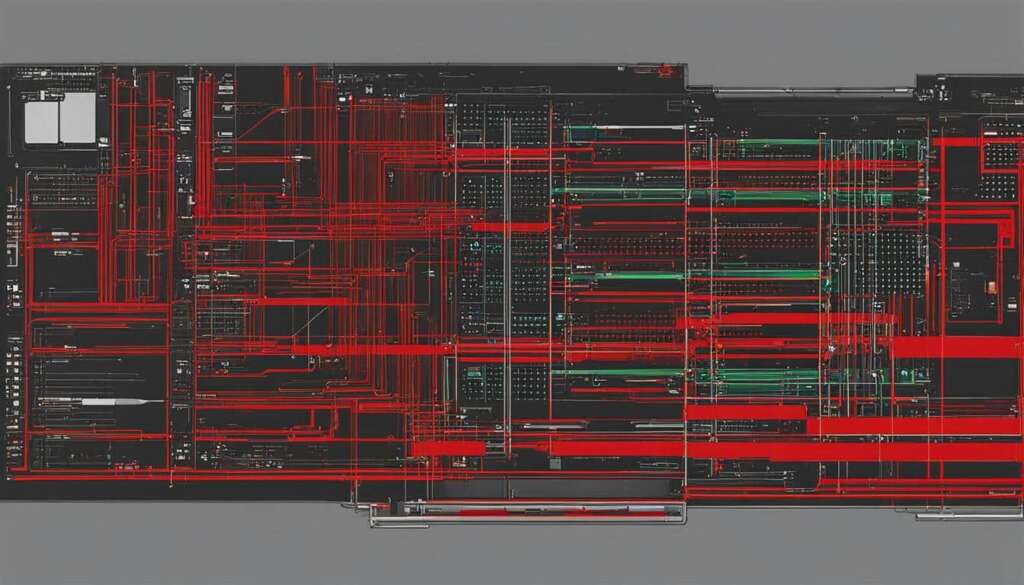Table of Contents
A firewall is a crucial component of cybersecurity that helps protect your computer or network from malicious or unnecessary network traffic. It acts as a barrier, shielding your digital assets and preventing unauthorized access to your system. There are different types of firewalls, including hardware and software options.
Hardware firewalls are physical devices that sit between your computer and the internet, providing an additional layer of defense. Software firewalls, on the other hand, are built-in features in operating systems or can be obtained separately. It’s essential to use a firewall and configure it properly to ensure maximum protection for your system.
If you want to safeguard your computer or network from cyber threats, understanding firewalls is essential. Let’s explore how firewalls work, the various types of firewalls available, the benefits they bring, and how to choose and configure the right firewall for your needs.
How do Firewalls Work?
Firewalls play a critical role in cybersecurity, functioning as filters that control the flow of network traffic. Understanding how firewalls work is essential for safeguarding your digital assets and protecting your private network.
Firewalls operate by examining data packets and determining which ones are safe to pass through and which ones pose a potential threat. They evaluate packets based on various criteria, including source and destination IP addresses, port numbers, packet protocols, and application protocols.
By analyzing these criteria, firewalls can filter out malicious or unnecessary traffic, ensuring that only legitimate data reaches your system. This filtering process enables firewalls to regulate inbound and outbound traffic and create rules that allow or deny connections.
Firewalls can be deployed at the network level or on individual user devices. Network-level firewalls provide centralized protection for an entire network, while device-level firewalls offer more specific control over individual endpoints.
Firewalls perform an important function in filtering and controlling traffic to protect your system. They act as a barrier between your network and the internet, preventing unauthorized access and potential cyber attacks.
Firewalls control the flow of web traffic by examining data packets and applying rules and criteria to determine their legitimacy.
By efficiently filtering traffic, firewalls strengthen security measures, shielding your private network and endpoint devices from potential threats.
Firewall Filtering Process
- Examine criteria such as source and destination IP addresses, port numbers, packet protocols, and application protocols.
- Filter out malicious or unnecessary traffic based on these criteria.
- Create rules to allow or deny connections based on the filtered traffic.
- Regulate inbound and outbound traffic to control the flow of web traffic.
| Criteria | Explanation |
|---|---|
| Source IP Address | The IP address of the device or system sending the data packet. |
| Destination IP Address | The IP address of the intended recipient of the data packet. |
| Port Numbers | Identifies specific services or applications associated with the data packet. |
| Packet Protocols | Determines the type of network protocol used in the data packet, such as TCP or UDP. |
| Application Protocols | Identifies the specific application or software used in the data packet. |
Types of Firewalls
When it comes to protecting your computer or network from unauthorized access and malicious network traffic, there are various types of firewalls available. Each type has its own unique approach to filtering traffic and enhancing security. Let’s explore the different firewall types:
- Packet-Filtering Firewalls: This is the most common type of firewall. It examines individual data packets and blocks them if they don’t match the established security rules. Packet-filtering firewalls analyze criteria such as source and destination IP addresses, port numbers, packet protocols, and application protocols to determine whether to allow or block the packets.
- Stateful Packet-Filtering Firewalls: These firewalls remember information about previously passed packets, enabling them to offer better security. By maintaining knowledge of the state of network connections, stateful packet-filtering firewalls make more informed decisions about allowing or blocking packets.
- Next-Generation Firewalls: Combining traditional firewall technology with additional functionality like anti-virus and intrusion prevention systems, next-generation firewalls provide advanced security features. They offer deep packet inspection, application awareness, and comprehensive threat intelligence, making them highly effective in protecting against modern cyber threats.
- Proxy Firewalls: Acting as intermediaries between two end systems, proxy firewalls provide an extra layer of security by filtering network traffic at the application level. They receive requests from clients, forward them to the server, and vice versa. Proxy firewalls help prevent direct connections between clients and servers, thus reducing the risk of network attacks.
- Network Address Translation (NAT) Firewalls: These firewalls allow multiple devices on a network to connect to the internet using a single IP address. NAT firewalls enhance security by hiding the internal IP addresses of devices from external networks, making it more challenging for attackers to target individual devices.
- Stateful Multilayer Inspection Firewalls: These firewalls combine the functions of packet-filtering and proxy firewalls, filtering packets at different layers of communication. Stateful multilayer inspection firewalls ensure trusted sources, reliable communication, and comprehensive security by examining packets at both the network and application layers.
In summary, each type of firewall offers a different approach to filtering network traffic and enhancing security. Understanding the different types can help you choose the right firewall for your specific needs, bolstering the protection of your computer or network.

Benefits of Using a Firewall
Integrating a firewall into your cybersecurity strategy provides numerous advantages for safeguarding your digital environment. These benefits include:
1. Protection Against Cyber Attacks
A firewall acts as a powerful shield, mitigating the risks posed by potential cyber attackers. By monitoring and filtering network traffic, firewalls identify and block malicious data packets attempting to breach your system’s defenses. This offers a vital layer of protection, preventing unauthorized access and fortifying your security measures against external threats.
2. Safeguarding Against Malicious Network Traffic
Firewalls are designed to identify and block suspicious network traffic originating from specific locations, applications, or ports. This capability ensures that only verified and necessary data passes through, reducing the risk of a cyber attack through potentially harmful or compromised sources.
3. Strengthening Security Measures
Implementing a firewall reinforces your overall security measures by establishing a robust barrier against cyber threats. Firewalls act as a dynamic defense mechanism, deterring and hindering the progress of attackers on multiple fronts. While firewalls alone cannot guarantee complete security, their role in conjunction with antivirus software and safe computing practices significantly strengthens your resilience to potential attacks.
4. Limiting Unauthorized Access
A firewall’s configuration allows you to regulate inbound and outbound traffic based on predefined rules. By granting or denying connections, firewalls ensure that only authorized users can access your network. This capability minimizes the risk of unauthorized individuals gaining entry, further enhancing the integrity of your system.
5. Protecting Your Digital Assets
Firewalls play a pivotal role in shielding your digital assets from potential harm. By filtering and scrutinizing network traffic, firewalls significantly reduce the likelihood of sensitive information falling into the wrong hands. This protection covers valuable data, intellectual property, customer information, and other critical assets.
While firewalls represent an essential component of your cybersecurity strategy, it’s important to note that they should be used in conjunction with other protective measures to achieve comprehensive security.
Choosing and Configuring a Firewall
When it comes to choosing a firewall, the decision to use one is of utmost importance, regardless of the specific type. Both hardware and software firewalls have their advantages and disadvantages.
Hardware firewalls are highly effective in protecting multiple computers and controlling network activity. However, they may require professional support for proper configuration and maintenance. On the other hand, software firewalls, often built-in to operating systems, offer individual application-level control but are limited by being located on the same system.
Properly configuring your firewall is crucial. Understanding the default settings, as well as regularly updating and managing it, are essential for optimal protection. While commercially available firewall products usually come preconfigured, it’s important to review the documentation and adjust settings to suit your specific needs.
When making your choice, weigh the pros and cons of hardware and software firewalls, considering factors such as your network size, budget, and level of technical expertise. By choosing the right firewall and configuring it correctly, you can enhance your system’s security and safeguard your valuable digital assets.
FAQ
What is a firewall and why is it important?
A firewall is a crucial component of cybersecurity that acts as a barrier, protecting your computer or network from malicious or unnecessary network traffic. It helps prevent unauthorized access and ensures the security of your digital assets.
How do firewalls work?
Firewalls work by filtering network traffic, examining packets based on criteria such as IP addresses, port numbers, and protocols. They regulate inbound and outbound traffic, creating rules to allow or deny connections and effectively control the flow of web traffic.
What are the types of firewalls?
There are several types of firewalls, including packet-filtering firewalls, stateful packet-filtering firewalls, next-generation firewalls, proxy firewalls, network address translation (NAT) firewalls, and stateful multilayer inspection firewalls.
What are the benefits of using a firewall?
Firewalls provide protection against outside cyber attackers, prevent unauthorized access, act as a barrier, and reduce the risk of cyber attacks. Using a firewall in conjunction with other protective measures strengthens your overall resistance to attacks.
How do I choose and configure a firewall?
The most important aspect is the decision to use a firewall rather than the specific type. Consider the advantages and disadvantages of hardware and software firewalls, configure the firewall properly, understand default settings, update and manage it regularly.













